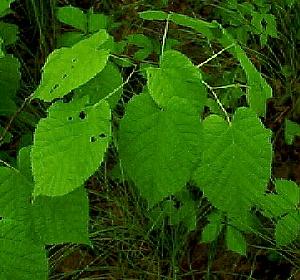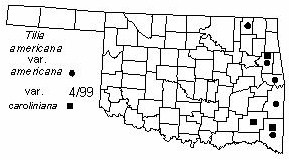
Tree to 18 m (60 ft) tall and 50 cm (20 in) in diameter with a dense crown. Bark gray, smoothish, divided into narrow scaly ridges on trunks and larger branches. Twigs gray to brown, glabrous to hairy. Buds egg-shaped, short-pointed, red-brown, with no terminal bud. Leaves alternate, long-stalked, broadly ovate or rounded, 6-15 cm (2.4-6 in) long and almost as wide, acuminate, coarsely serrate, cordate to nearly straight at the base, shiny dark green above, paler and more or less hairy below. Flowers in cymes hanging on a long stalk from a strap-shaped green bract, yellowish-white, fragrant, about 15 mm (0.6 in) wide, blooming in early Summer. Fruits several in a cluster, nutlike, about 10 mm (0.4 in) in diameter, maturing in late Summer or Fall.
Distribution: The two varieties together are spread over much of the eastern U. S. and southeastern Canada. Variety americana is more northern and var. caroliniana is more southern, but their distributions overlap.
Habitat: Moist upland forests, well-drained floodplain forests.
NWI status: none
Comment:This taxon is often divided into two species. According to E. L. Little (1981) the two species/varieties intergrade in eastern Oklahoma. Tilia is the old Latin name for the basswoods and lindens; americana refers to North America; caroliniana refers to the Carolina colonies.
Distribution in Oklahoma: 
BACK
NEXT
RETURN TO INDEX
Last update: 9/20/99
 Go to Oklahoma Biological Survey Home Page
Go to Oklahoma Biological Survey Home Page
 Disclaimer
Disclaimer